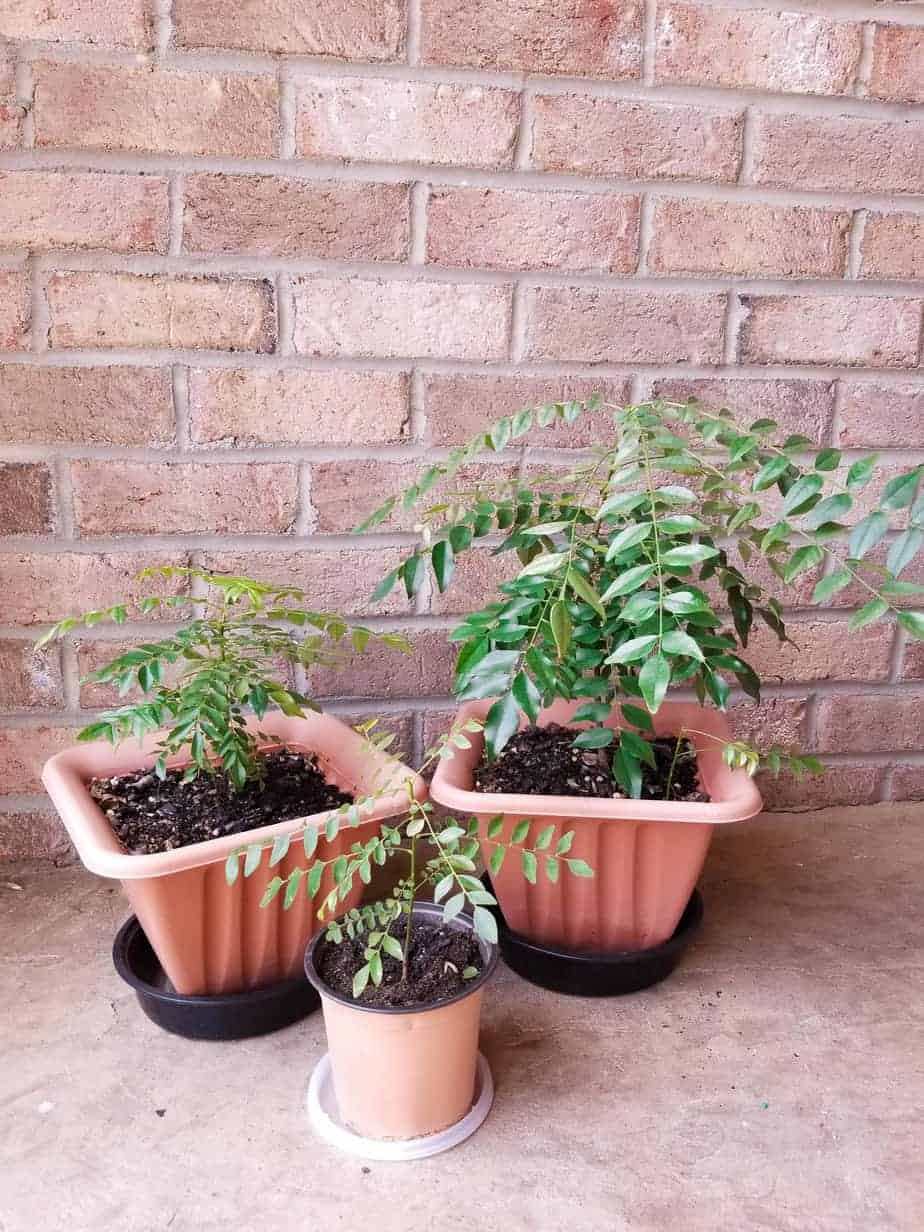In the last couple of days, I have received several inquiries through my Facebook Page, requesting more information regarding how to transplant or re-pot a Curry Leaf Plant or Kadi patta in a new pot.
Here’s what you need to do, once you buy a new baby Curry Leaf Plant (Check out this page: 3 Things To Consider When Buying A Curry Leaf Plant), or want to transplant an existing Curry Leaf Plant to a new container.
Being native to humid jungles of South East Asia, Curry leaf plant likes warm, humid weather. Curry Leaf plant will not survive below freezing temperature. If you live in an area where the temperature goes around or below freezing during winter, you should consider planting your Curry leaf plant in a pot or container which you can bring inside your house or move to a sheltered space.
Here is a complete Curry Leaf Plant Care guide.
When to Transplant/Re-pot a Curry Leaf Plant:
Early spring is the best time to transplant a curry leaf plant into a new container. If for some reason the middle of the year transplant is required, make sure to do it on a cloudy day during morning hours.
The Curry Leaf Plant doesn’t like its roots disturbed too frequently. Every time the plant is transplanted, it will go through a shock period, when it will stop growing for a while. For this reason, it is best to transplant a curry leaf plant only when needed. For example:Early spring is the best time to transplant a curry leaf plant into a new container. If for some reason the middle of the year transplant is required, make sure to do it on a cloudy day during morning hours.
– To transfer a baby Curry Leaf Plant from a starter pot to a bigger container.
– To change the current container soil of a mature plant- every two years is recommended.
– When you see the roots coming out of the drainage hole of the container- a bigger pot is needed.
What size pot is best for Curry Leaf Plant?
Any ceramic, resin or terracotta plastic container would work for Curry leaf plant. However, since most likely you’ll have to move the plant back and forth inside and outside the house seasonally, lightweight resin container is the best.
Whatever the material you choose for the container, make sure it has an adequate amount of drainage hole in the bottom of the container.
Picking the right size container for the curry leaf plant is essential. You do not want a huge container for a small plant.
When you transplant a Curry leaf plant in a new pot, the plant will divert its energy in growing the roots. Once the roots start touching the side of the container, the plant will focus energy on growing vertically by producing more leaves. For this reason, the container size should be in proportion to the plant size.
The newly transplanted Curry leaf plant can stay in this container for one to two years. In the spring after the transplant, you should consider whether the plan requires a new pot.
As a general rule of thumb, if the plant topples over in the windy conditions, the pot is too small for the plant. It’s time for a bigger pot.
Here’s my secret for keeping the Curry Leaf Plant happy and well watered:
Keep a shallow plastic dish or an empty takeout container under the Curry leaf plant container to catch the excess water. In the summer months, during a dry spell or heatwave, the curry leaf plant will soak up the excess water stored in the dish. That also reduces the frequency of watering the plant.

Best potting mix for Curry Leaf Plant:
The Curry Leaf Plant likes slightly acidic (Soil PH between 5.6 to 6 ), loose, and well-drained soil. After watering, the access water should run away from the drainage hole below the pot to prevent roots from rotting.
Any kind of potting mix available in the big box stores will work for the curry leaf plant. I recommend Cactus Potting Mix or Citrus Potting Mix. Make sure to buy the ‘Potting Mix,’ not the ‘Potting Soil.’ Add 1/2 amount of compost or cow manure to the potting mix for the best growth. Mix the potting mix and cow manure well before planting the curry leaf plant.
I do not recommend putting garden soil in the container. The garden soil has many bacteria, parasites, and insects that can infect or harm the growth of your Curry leaf plant. Additionally, when you bring the container indoors during colder months, you do not want to bring garden pests in that can infect other indoor plants.
Some people like to fill the container halfway with pebbles or plastic bottles before adding the soil, effectively reducing the soil required and making the container light when filled. I personally don’t implement this trick.
Okay, let’s gather your container gardening tools, and get started.
How to transplant a Curry Leaf Plant:
Step 1: Fill the container halfway with potting soil.
Step 2: Take out the Curry leaf plant from the current container. Gently ruffle the roots, if the roots are growing in the circular direction. Put the plant in the new container.
Step 3: Fill the container with the rest of the potting mix and compost mixture up to 1.5” to 2” inch below the edge of the container.
Step 4: Gently press around the base of the plant to take out any air bubbles trapped under the Soil.
Step 5: Sprinkle fertilizer like Blood Meal on the top later. Mix the top soil well.
Step 6: Pour water gently around the base of the plant until you see the water running out from the drainage hole of the pot. Wait for 5 to 10 minutes and then water again.
Step 7: Put the container in a warm, sunny spot. Make sure the plant receives 6 to 8 hours of direct sunlight every day.
How often to water a Curry Leaf Plant:
The Curry Leaf Plant does not like to be over-watered. If the plant gets too much water, the roots will start rotting. It is best to water the curry leaf plant infrequently but deeply. Water the plant when you see the topsoil is dry to touch.
Scratch on the top surface of the potting soil. If the soil below 0.5” of the surface is dry, it’s time to water. Water near the base of the plant until you see water running out from the bottom. Wait for a few minutes, and then water again.
Here is another secret tip:
Leaving the plant thirsty for an extra day makes the root grow longer. Over-watering does not help, but under-watering does!
Of course, use your best judgment during the hot summer months.
Best fertilizers for Curry Leaf Plants:
Apply Blood meal to the top layer of soil at the beginning of spring. Gently shuffle the top 2 to 3 inches of soil. Follow a regular schedule of liquid fertilizer like Neptune’s Seaweed and Fish Fertilizer. Continue until late summer.
Check out related article: Best Fertilizers For Curry Leaf Plant- Natural and Organic Options
If you have any question about planting your Curry leaf plant in a new container, please feel free to leave a comment below.
Want to know more about growing a Curry Leaf Plant?
- 3 Things to Consider Before Buying a Curry Leaf Plant
- Curry Leaf Plant Care Guide
- Best Fertilizers For Curry Leaf Plant- Natural And Organic Options
- How to prune a curry leaf plant to make it bushy
Ask your questions:
If you have any question regarding growing curry leaf plant or any other vegetable gardening matter, connect with me on Pinch of seeds group on Facebook. You can ask questions, post a picture for photo consultation, get personalized response and interact with other gardeners.
Last updated: 11/11/2020




Where would you suggest purchasing a Curry Leaf plant from? There is no one local that I can find.
I have about 12″curry leaves plant and about 2 years old, the branches and the leaves are getting down before it was up and straight even leaves are inverted what could be the reason.
Hello,
I am planning to transplant my plant into a bigger pot. How deep can I plant it? Does the stem needs to be at the same soil level as it is right now? My plant is 4-5″ tall with bunch of stems on top. Stem is very thin and needs support otherwise it will topple. I was thinking if it’s okay to immerse the stem in soil just like tomato plant.
Hi Shilpa!
Yes, you should plant the curry leaf plant at the same soil level as it is in the current pot. You can support the curry leaf plant stem by placing a twig or stick besides the stem and loosely tying both with a string.
– Gopi
I think I found answers to my questions, posted to you within last 15 minutes, while checking your website. However, a personal response would be nice too!
How can I find a “nursery”,close to where I live, to buy the curry leaf plant?
Urvashi
Hi Gopi,
My curry leaf plant is 10″ i think. I want plant in the ground, when it is small. Is it ok to plant in the ground when it is small. If it is ok then can i plant in mid march. I am California. Temperatures are dropping in the night.
Thank you.
Hi Krishna!
If your location does not get freeze during winter, then yes, it is perfectly fine to plant the curry leaf plant in the ground. In a few years, you will be rewarded with a ‘Curry Leaf Tree’! Best time to plant a curry leaf plant is in early Spring.
-Gopi
I have about 10feet curry leaves tree. I want to move/transport it to my new home. Please lmk tips. Thanks
Hi, I am in Australia in a warm climate and want to transplant my curry plant into a pot as I am moving house. It is a small shrub now the main trunk would no thicker than a medium thick branch on a small tree. Am I able to successfully transplant it into a large pot….kind regards Judy
Yes, You can transplant the curry leaf tree from one pot to another pot. You should select the largest pot size you can, to make sure there is enough room for the curry leaf tree roots to grow. During the transition, it is possible that the leaves turn yellow, or fall off. But Curry leaf plants are very resilient. It will bounce back from the transplant shock, if well take care of.
Good luck with your move. Let me know how the curry leaf transplant goes.
– Gopi
Can we use dried up cow dung cakes (that we usually see in our indian villages thats used for cooking) for fertilizing instead of cow manure? And if can how to use it?
Yes you can! Let a cow dung cake soak in a bucket full of water overnight (or longer). Mix 50% liquid cow dung water and plain water in a watering can or bucket. Use this mix to water the plant near the base. You can repeat the application every 6 to 8 weeks.
I’ve put in 4 cuttings of curry leaf stalks in one pot (I live in an apartment). I was thinking I’ll transplant them into individual pots once they get rooted and start growing new leaves. Will this plan work or should I have planted the cuttings in 4 separate pots right from the start? Or is it ok to grow all 4 cuttings in the same pot?
Hi Vasu,
Yes, you can keep all 4 of the curry leaf stems in one pot until Spring. Then you can separate the once which sprouted into 1 per pot.
Good luck!
– Gopi
Thank you for your amazing guidance. I just got my first small 4 inch stem plant from a neighbor and she placed it in a small pot. ( the plastic kind which hold herbs at nurseries) Should I put it in another small pot or wait for a year or two before moving it to another pot?
I have 2 plants in my pot, both are 3 years old. I am thinking of separating them. Is this the right time to do it? As it’s end of June. Temperatures are in 80s now. How can I safely separate them without killing the roots? I am sure some of them might be tangled together
I see lots of baby centepede kind of worms in my pot, is that normal? I used to add banana peels etc in my pot, is it due to that?
I pruned it in March, and after that all the new leaves are very light green/yellowish and I can see the veins as dark. It doesn’t look healthy, it used to be very dark green leaves before. Is that due to any nutrition problem? What fertilizer shud I use to fix it?